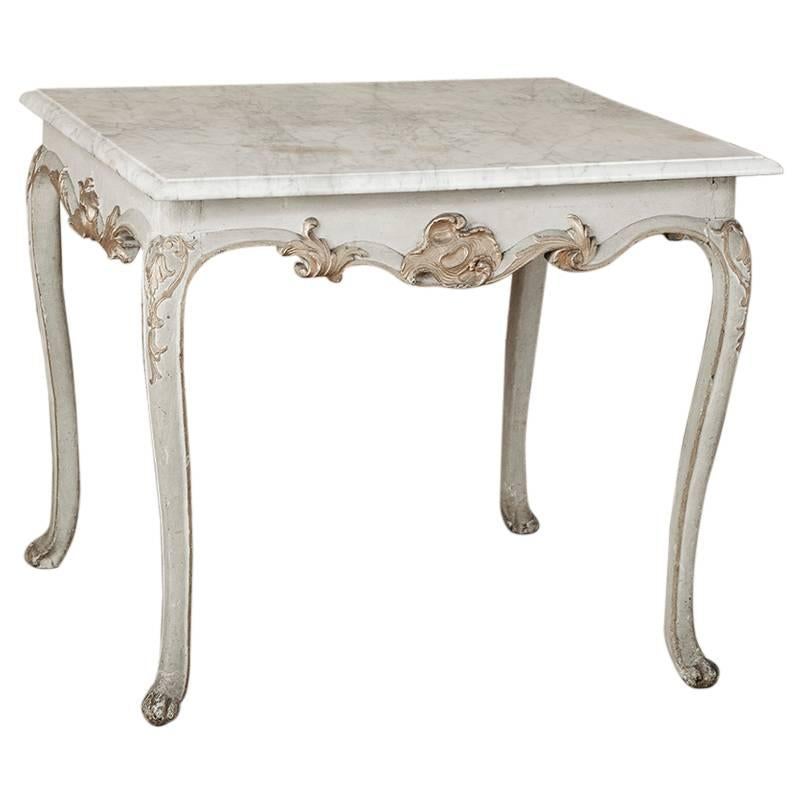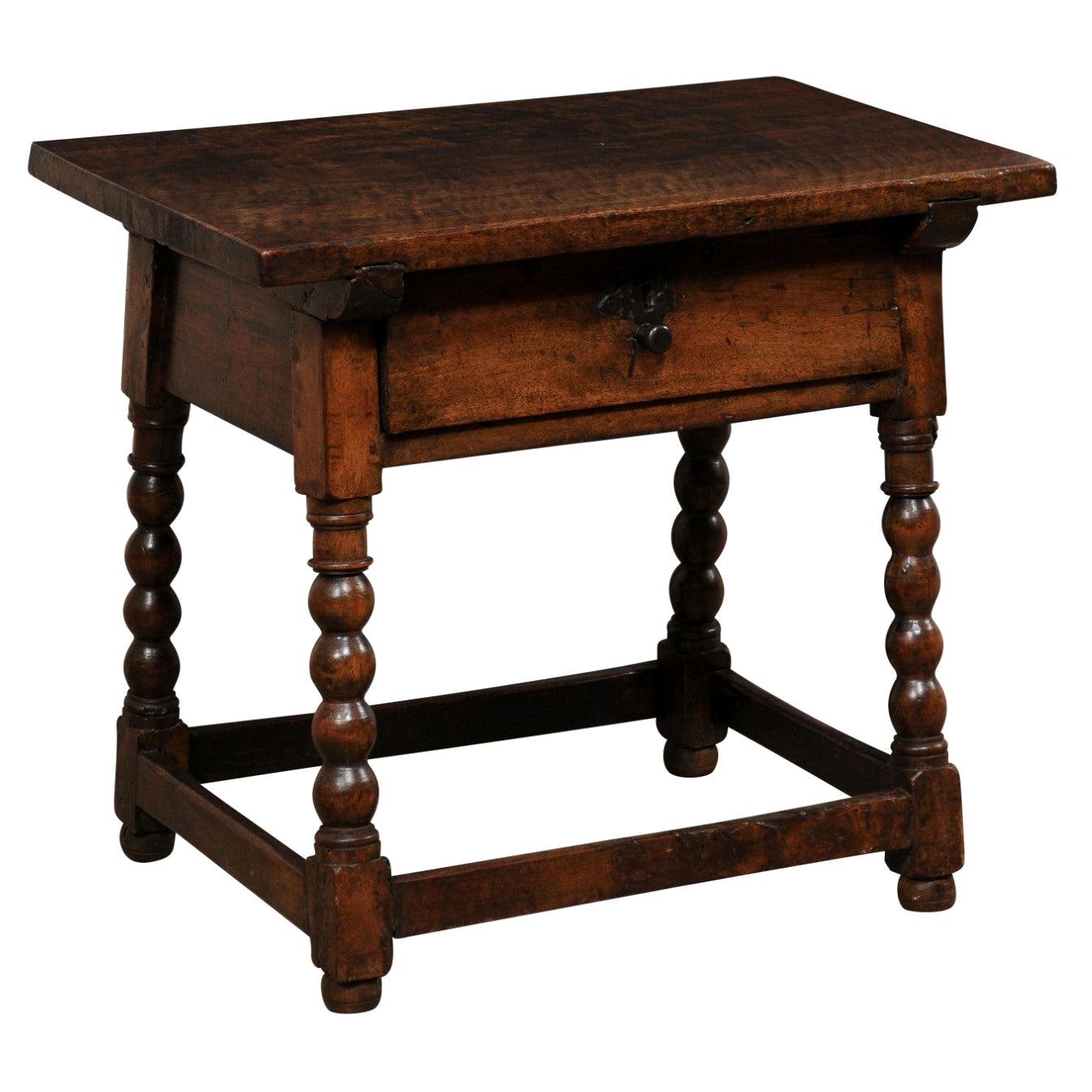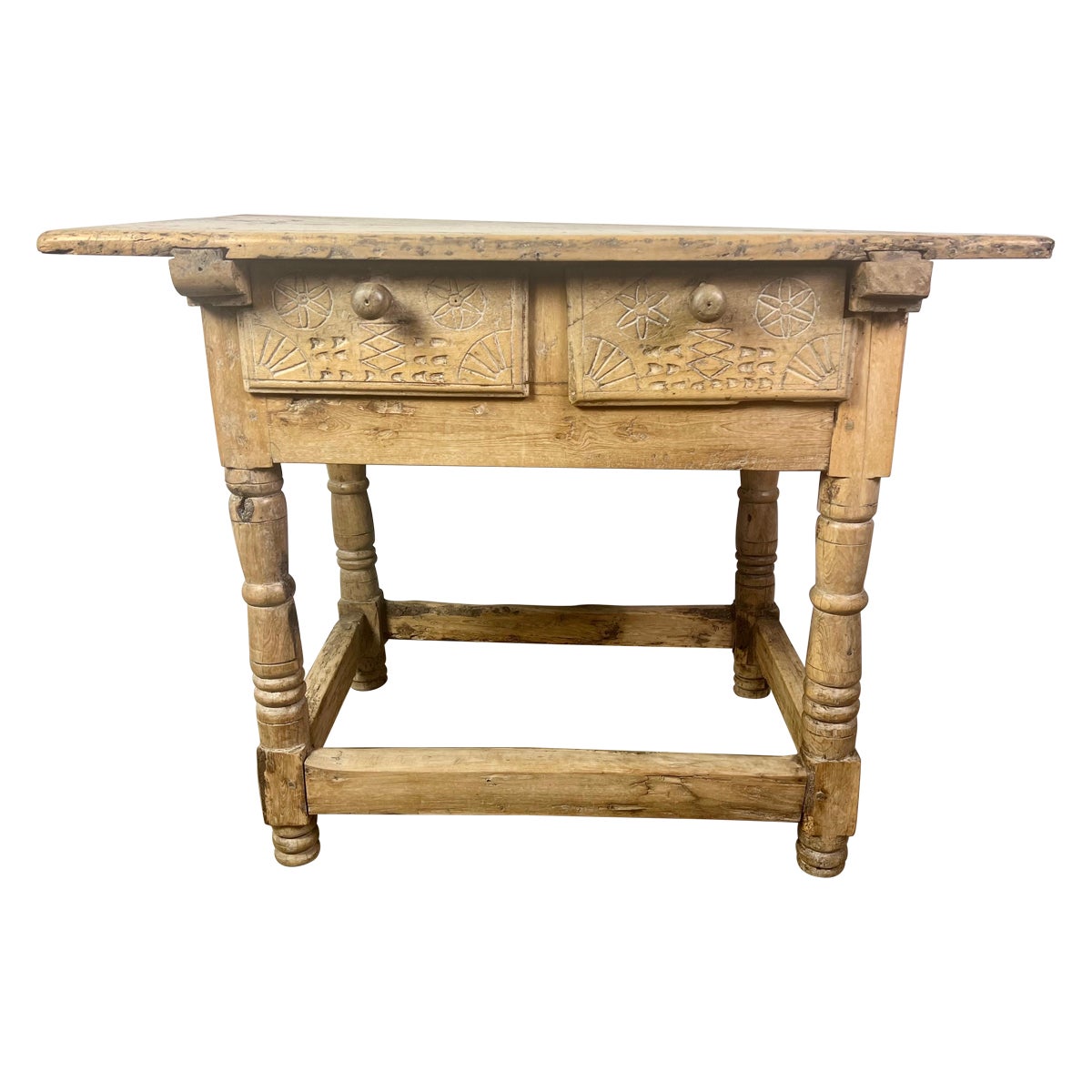Items Similar to Rare 18th Century Colonial Porringer Table
Want more images or videos?
Request additional images or videos from the seller
1 of 11
Rare 18th Century Colonial Porringer Table
About the Item
A most unusual and charming rustic Colonial tiled top porringer tea table, handcrafted in the late 1700s, presenting with a beautiful set of eight inset period Dutch Delft ceramic art tiles decorated with central rose floral pattern with fiolate secondary motif, executed in the sought-after purple brownish blackish manganese color, framed by interestingly shaped demilune like oak top with protruding rounded corners in the front, over a single frieze drawer with dovetail joinery, flanked by visible pegged construction, well shaped scalloped apron, rising on elaborately shaped and sculpted hand carved legs, joined by stretchers. It has added elements from over the centuries.
This extremely scare antique table is rustically refined, elegantly sophisticated, beautifully aged mixed wood with rich, warm patina, superb grain patterns, very versatile, useful and full of old world character and charm!
Dimensions (approx):
29" tall x 27" wide x 18" deep.
- Dimensions:Height: 29 in (73.66 cm)Width: 27 in (68.58 cm)Depth: 18 in (45.72 cm)
- Materials and Techniques:Delft,Oak
- Period:
- Date of Manufacture:Late 18th Century
- Condition:Wear consistent with age and use.
- Seller Location:Forney, TX
- Reference Number:1stDibs: LU5977227416362
About the Seller
4.8
Platinum Seller
These expertly vetted sellers are 1stDibs' most experienced sellers and are rated highest by our customers.
Established in 2013
1stDibs seller since 2021
200 sales on 1stDibs
Typical response time: <1 hour
- ShippingRetrieving quote...Ships From: Forney, TX
- Return PolicyA return for this item may be initiated within 7 days of delivery.
More From This SellerView All
- 19th C. French Charles X Restoration Period Sewing Stand Work TableLocated in Forney, TXA scarce period Charles X (1818-1834) French Restoration mahogany travailleuse sewing (thread stand - side table - jewelry dressing table) with light, warm, beautifully aged patina. Born in France in the early 19th century, almost certainly Parisian work, exquisitely hand-crafted, this exceptionally executed example features ornate gilt bronze ormolu mounts, escutcheons, and elaborate gilt metal trim. Having a highly figured light mahogany hinged lid top, lifting open to reveal a striking finished interior with divided compartments and original inset mirror plate. The conforming rectangular case fitted with a faux drawer front over a dovetailed drawer with sectioned interior. Elegantly rising on oval-shaped medial shelf stretcher-joined curvacious legs. Dimensions (approx): 27" High, 20" Wide, 13.5" Deep Stunning light almost blonde antique mahogany coloring and mellow warm tone, superb wood grain detail, and charming, beautifully aged patina over the whole. Great shape overall. Retaining original antique character marks, wear consistent with age and indicative of minimal use, nothing that detracts from the aesthetics or functionality, but only adds to the overall authenticity, refined elegant warmth, luxurious sophistication, and cozy unpretentious rustic elegance. Delivered cleaned, hand waxed, polished French patina finish, ready for immediate use and generational enjoyment! What is Charles X style: The comte d’Artois – or Charles X - was the son of the dauphin Louis-Ferdinand de Franc and Marie-Josèphe de Saxe. He succeeded his two brothers Louis XVI and Louis XVIII and became the King of France in 1824. Thirty years after the French Revolution, he wanted to embody the return of monarchy and became the leader of the catholic party . As the previous kings, he was crowned in 1825 but he was soon overthrown by the revolution in July, 1830, called "Trois Glorieuses". He left then for England, Scotland, Prague and Istria where he died in 1836. Charles X style lasted from 1818 to 1834 and happened during the Bourbon Restoration (French Restoration). This style did not replace totally the style of furniture from the French Empire but it was different from the formalism in the Napoleonic era, during which strictness and simplicity were inspired by Greco-Roman art. Indeed, artistic fields flourished. In terms of furniture, this renewal was suggested by the softening of shapes. Even though the simple aspect from the French Empire was still visible, shapes became curvier with volutes and arabesques. Another distinction is the loss of the massive aspect of furniture and the decrease of dimensions in order to decorate smaller appartments. Handling ability and comfort were key-words in the making of furniture. Apartments had essential elements such as chests of drawers, big rounded tables in the dining room, desks or secretaries, armoires and even dressing tables, comfortable fainting couches in the living room, small tables, pedestal tables, as well as gondola chairs. The wavy aspect of the latters certainly represent Charles X style the best. One of the most emblematic features of this style is the use of bois clairs – light woods in warm blond tones - and indigenous woods that are varnished in order to highlight the grains. Bird's-eye maple, ash trees, plane trees, yew trees, beech trees, olive trees and cedar trees were most likely to be used. Indeed, at the beginning of the 19th century dark woods were hard to find. In 1806, the Napoleon’s Continental System was established in order to ruin the United Kingdom by preventing the country from any business with the rest of Europe. Therefore craftsmen had to find alternatives from mahogany which was the most commonly used material at this time. After 1815, the import of wood was even more difficult because of peace treaties and the European political situation, which contributed to the popularity of the bois clairs and indigenous woods. The furniture was often decorated with fine inlays made out of dark wood representing foliage, which contrasted with the veneer. Even though these patterns can look like bronze decorations from the Empire era, they were far more simple and did not represent any military or mythological attributes. On the tables, trays were sometimes made out of marble as in the French Empire, but it was often put aside and inlaid veneer, Verre Eglomisé – a type of glass with a mirror finish –, mirror or porcelain from Sèvres or Paris were more likely to be used. Decorative elements from the Monarchy were highly appreciated again as they suggested luxury. Indeed, marquetry work was particularly fashionable - Boulle marquetry thrived around 1820 as the works of the Levasseur family can show. In the same way, draperies and trimmings referred to the monarchist splendour. Fabrics were often white – the traditional colour of the Bourbons – or light coloured as oppposed to the typical green from the Napoleonic era. One of the most symbolic figures from this period of time might be Jean-Jacques Werner (1791-1849), a cabinetmaker who worked for prestigious clients such as the Duchesse de Berry who was Charles’s step-daughter. His works can be seen at the Musée des Arts Décoratifs and at the Grand Trianon in the Palace of Versailles. The duchess’s appartments situated at the pavillon de Marsan and at the Palais de Saint Cloud illustrate Charles X style the best with furniture made out of bois clairs and ornamented with dark wood patterns or fine gold decorations. Chales X style allows a transition between the sobriety of the Empire style and the abundant aspect of Louis-Philippe style. The gothic style started at this time through the "style à la cathédrale", inspired by religious architecture, which thrived from 1827 to 1830. Indeed, at the beginning of the 19th century, Romanticism put the spotlight on the Middle Ages. Cabinetmakers were not inspired by the medieval furniture but rather by architectural elements of churches and cathedrals. For instance the backs of chairs were decorated with arches shaped like rib and serration. In the same way, before Charles X abdicated, pieces of furniture were made out of dark woods – such as mahogany, which was used again in France – and were inlaid with light wood. Romanticism also influenced the layout of furniture in appartments to suggest movement through a mix of various styles, various shapes and various sizes, as opposed to the static aspect of Neoclassicism. The start of industrialisation and mechanisation also influenced this style as early technical developments led to the production of pieces of furniture in series. Credit: Marc Maison Bibliography: FANIEL Stéphane (Dir.), Le Dix-neuvième Siècle Français, Collection Connaissance des Arts, 1957, Hachette SASSONE, Adriana Boidi, Furniture from Rococo to Art Deco, 2000, Evergreen -- Extremely versatile: As warm and attractive as it is useful, this remarkable antique table having the ideal size and small proportions for a variety of different uses, including as a side table, accent or occasional table, tall sofa...Category
Antique Early 19th Century French Charles X End Tables
MaterialsBronze, Ormolu
- 18th/19th Century Rococo Louis XV Style Console TableLocated in Forney, TXA stunning and impressive size Continental (Italian or Swedish, possibly French) carved and painted antique console table. circa 1800 ...Category
Antique Late 18th Century European Louis XV Console Tables
MaterialsMarble
- 18th Century Spanish Baroque Period Carved Walnut Geometric TableLocated in Forney, TXA remarkable one-of-a-kind Spanish Baroque Period hand carved walnut table with beautifully aged warm rustic distressed patina. Hand-crafted in Spain in the first half of the 18th century, with later architectural elements, having a rectangular single board plank top with breadboard batten ends and desirable overhang, above deep geometric pattern carvings to three sides of the apron and chip carved running ornamentation to the back, elevated on tall hand turned legs. A wonderful way to add authentic antique character, rustic warmth, and European old world charm! Dimensions (approx) 32" Tall, 56.5" Wide, 27" Deep As warm and attractive as it is useful, having the ideal large size and proportions for a variety of different uses, including as a Mediterranean Revival dining sideboard server - buffet table...Category
Antique 18th Century Spanish Baroque Tables
MaterialsWalnut
- 18th/19th Century Qing Dynasty Chinese Root-Wood Low TableLocated in Forney, TXA rare Chinese ebonized rootwood table, Qing Dynasty, dating to the second half of the 18th century to early 19th century. The impressive black lacquere...Category
Antique 18th Century Chinese Qing Coffee and Cocktail Tables
MaterialsWood
- Vintage Edward Wormley for Dunbar Furniture Occasional TableBy Edward Wormley, Dunbar FurnitureLocated in Forney, TXA beautiful and fine American Mid-Century custom ordered side table, model 426A, designed by Edward Wormley (American, 1907-1995) for Dunbar Furniture; Berne, Indiana. Circa 1950-196...Category
Mid-20th Century American Mid-Century Modern End Tables
MaterialsBrass
- Vintage French Louis XV Style Painted Wicker TableLocated in Forney, TXA substantial, heavy, 3/4" thick circular glass top with 1" beveled edge rests atop a French Louis XV style table, charming antiqued finish distressed painted green with partial gilt accents, having a highly decorative cane webbed rattan wicker decorated top forming concentric circles of unique patterns within a round serpentine shaped molded edge top, over a gently undulating scalloped apron, rising on faux bamboo cross-stretcher joined carved cabriole legs, terminating in whorl feet. Attributed to historic American retailers Barker Brothers Furniture...Category
Late 20th Century Louis XV End Tables
MaterialsFaux Bamboo, Wicker, Cane, Rattan, Glass, Paint
You May Also Like
- 18th Century French Painted and Gilded Carrera Marble Top Table, Circa 1760.Located in Dallas, TX18th Century French Period Painted and Gilded Carrera Marble Top Table. The elegant details on this Louis XV style French table have been highlighted by the hand-applied antique gild...Category
Antique 1760s French Louis XV Tables
MaterialsMarble
- 17th-18th Century Spanish Colonial Walnut Trestle TableLocated in West Palm Beach, FLTrestle table of walnut, having a rectangular top of a single plank, raised on lyre-cut legs, and joined by decorative ironwork stretcher. Stock ID: D3351Category
Antique Early 18th Century Italian Spanish Colonial Tables
MaterialsWrought Iron
- 18th C. Italian Occasional Table w/Drawer Raised on Ball Turned & Carved LegsLocated in Atlanta, GAAn Italian occasional table with single drawer, from the 18th century. This antique table from Italy has a rectangular-shaped top, which overhangs the apron below which houses a single drawer at one side. The table is raised on four ball-turned and carved legs (which angle outward slightly). The legs are braced with a box stretcher just above their feet. This piece, which is either walnut or tiger maple wood, has a fabulous old patina; a beautiful reflection of is long history and use. This 18th century Italian table with drawer...Category
Antique 18th Century Italian Tables
MaterialsWood
- Rare 18th Century Walnut Tea & Silver TableLocated in Bedfordshire, GBAn extremely rare mid 18th century George II period walnut tea table having well figured foldover top enclosing divisions to well raised on elegant turned legs with carved lappet ...Category
Antique Mid-18th Century English George II Card Tables and Tea Tables
MaterialsWalnut
- Rare 18th Century English Elm Turned Leg TableLocated in Greenwich, CTRare and unusual 18th century English elm tripod table with balustrade turned shaft supported by turned legs ending in blunt arrow feet. This lovely example is in a perfect state of ...Category
Antique 1740s English End Tables
MaterialsElm
- 18th Century Bleached Walnut Spanish Colonial Table with Two DrawersLocated in Los Angeles, CA18th century bleached walnut Spanish Colonial table with two drawers. The four legs are connected by a stretcher. The two drawers have primitive style carvings. It is beautifully wo...Category
Antique 18th Century Spanish Spanish Colonial Tables
MaterialsWalnut
Recently Viewed
View AllMore Ways To Browse
Table 18 Century
Antique 18th Century Table
18th Century Oak Table
Scallop Apron Table
Scalloped Table Apron
Rising Table
Antique Colonial Table
Late 18 Century Tables
18th Century Round Table
Antique Round Table With Drawer
Round Antique Table With Drawer
Antique Art Tiles
Antique Art Tile
Handcrafted Antique Table
Colonial Wood Table
Antique Round Oak Table
Antique Round Oak Tables
Antique Oak Round Table





